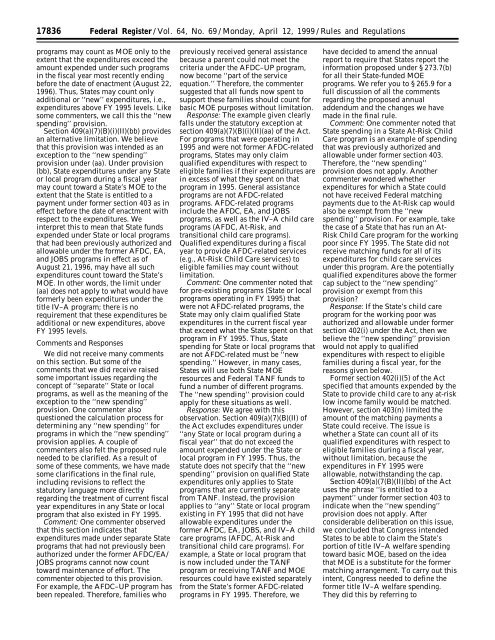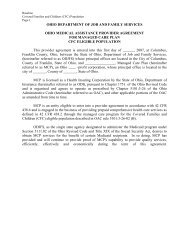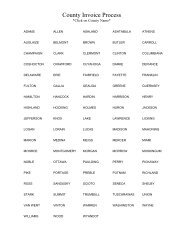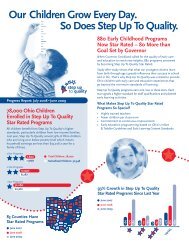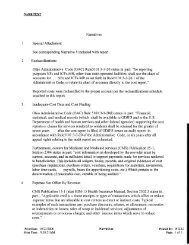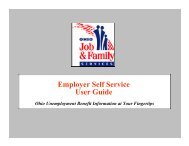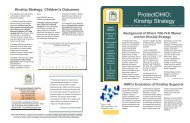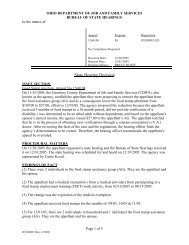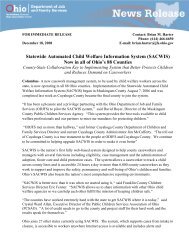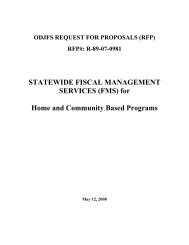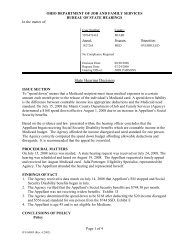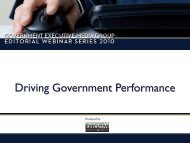Final TANF Rule as published in the Federal Register 4/12/1999
Final TANF Rule as published in the Federal Register 4/12/1999
Final TANF Rule as published in the Federal Register 4/12/1999
Create successful ePaper yourself
Turn your PDF publications into a flip-book with our unique Google optimized e-Paper software.
17836 <strong>Federal</strong> <strong>Register</strong> / Vol. 64, No. 69 / Monday, April <strong>12</strong>, <strong>1999</strong> / <strong>Rule</strong>s and Regulations<br />
programs may count <strong>as</strong> MOE only to <strong>the</strong><br />
extent that <strong>the</strong> expenditures exceed <strong>the</strong><br />
amount expended under such programs<br />
<strong>in</strong> <strong>the</strong> fiscal year most recently end<strong>in</strong>g<br />
before <strong>the</strong> date of enactment (August 22,<br />
1996). Thus, States may count only<br />
additional or ‘‘new’’ expenditures, i.e.,<br />
expenditures above FY 1995 levels. Like<br />
some commenters, we call this <strong>the</strong> ‘‘new<br />
spend<strong>in</strong>g’’ provision.<br />
Section 409(a)(7)(B)(i)(II)(bb) provides<br />
an alternative limitation. We believe<br />
that this provision w<strong>as</strong> <strong>in</strong>tended <strong>as</strong> an<br />
exception to <strong>the</strong> ‘‘new spend<strong>in</strong>g’’<br />
provision under (aa). Under provision<br />
(bb), State expenditures under any State<br />
or local program dur<strong>in</strong>g a fiscal year<br />
may count toward a State’s MOE to <strong>the</strong><br />
extent that <strong>the</strong> State is entitled to a<br />
payment under former section 403 <strong>as</strong> <strong>in</strong><br />
effect before <strong>the</strong> date of enactment with<br />
respect to <strong>the</strong> expenditures. We<br />
<strong>in</strong>terpret this to mean that State funds<br />
expended under State or local programs<br />
that had been previously authorized and<br />
allowable under <strong>the</strong> former AFDC, EA,<br />
and JOBS programs <strong>in</strong> effect <strong>as</strong> of<br />
August 21, 1996, may have all such<br />
expenditures count toward <strong>the</strong> State’s<br />
MOE. In o<strong>the</strong>r words, <strong>the</strong> limit under<br />
(aa) does not apply to what would have<br />
formerly been expenditures under <strong>the</strong><br />
title IV–A program; <strong>the</strong>re is no<br />
requirement that <strong>the</strong>se expenditures be<br />
additional or new expenditures, above<br />
FY 1995 levels.<br />
Comments and Responses<br />
We did not receive many comments<br />
on this section. But some of <strong>the</strong><br />
comments that we did receive raised<br />
some important issues regard<strong>in</strong>g <strong>the</strong><br />
concept of ‘‘separate’’ State or local<br />
programs, <strong>as</strong> well <strong>as</strong> <strong>the</strong> mean<strong>in</strong>g of <strong>the</strong><br />
exception to <strong>the</strong> ‘‘new spend<strong>in</strong>g’’<br />
provision. One commenter also<br />
questioned <strong>the</strong> calculation process for<br />
determ<strong>in</strong><strong>in</strong>g any ‘‘new spend<strong>in</strong>g’’ for<br />
programs <strong>in</strong> which <strong>the</strong> ‘‘new spend<strong>in</strong>g’’<br />
provision applies. A couple of<br />
commenters also felt <strong>the</strong> proposed rule<br />
needed to be clarified. As a result of<br />
some of <strong>the</strong>se comments, we have made<br />
some clarifications <strong>in</strong> <strong>the</strong> f<strong>in</strong>al rule,<br />
<strong>in</strong>clud<strong>in</strong>g revisions to reflect <strong>the</strong><br />
statutory language more directly<br />
regard<strong>in</strong>g <strong>the</strong> treatment of current fiscal<br />
year expenditures <strong>in</strong> any State or local<br />
program that also existed <strong>in</strong> FY 1995.<br />
Comment: One commenter observed<br />
that this section <strong>in</strong>dicates that<br />
expenditures made under separate State<br />
programs that had not previously been<br />
authorized under <strong>the</strong> former AFDC/EA/<br />
JOBS programs cannot now count<br />
toward ma<strong>in</strong>tenance of effort. The<br />
commenter objected to this provision.<br />
For example, <strong>the</strong> AFDC–UP program h<strong>as</strong><br />
been repealed. Therefore, families who<br />
previously received general <strong>as</strong>sistance<br />
because a parent could not meet <strong>the</strong><br />
criteria under <strong>the</strong> AFDC–UP program,<br />
now become ‘‘part of <strong>the</strong> service<br />
equation.’’ Therefore, <strong>the</strong> commenter<br />
suggested that all funds now spent to<br />
support <strong>the</strong>se families should count for<br />
b<strong>as</strong>ic MOE purposes without limitation.<br />
Response: The example given clearly<br />
falls under <strong>the</strong> statutory exception at<br />
section 409(a)(7)(B)(i)(II)(aa) of <strong>the</strong> Act.<br />
For programs that were operat<strong>in</strong>g <strong>in</strong><br />
1995 and were not former AFDC-related<br />
programs, States may only claim<br />
qualified expenditures with respect to<br />
eligible families if <strong>the</strong>ir expenditures are<br />
<strong>in</strong> excess of what <strong>the</strong>y spent on that<br />
program <strong>in</strong> 1995. General <strong>as</strong>sistance<br />
programs are not AFDC-related<br />
programs. AFDC-related programs<br />
<strong>in</strong>clude <strong>the</strong> AFDC, EA, and JOBS<br />
programs, <strong>as</strong> well <strong>as</strong> <strong>the</strong> IV–A child care<br />
programs (AFDC, At-Risk, and<br />
transitional child care programs).<br />
Qualified expenditures dur<strong>in</strong>g a fiscal<br />
year to provide AFDC-related services<br />
(e.g., At-Risk Child Care services) to<br />
eligible families may count without<br />
limitation.<br />
Comment: One commenter noted that<br />
for pre-exist<strong>in</strong>g programs (State or local<br />
programs operat<strong>in</strong>g <strong>in</strong> FY 1995) that<br />
were not AFDC-related programs, <strong>the</strong><br />
State may only claim qualified State<br />
expenditures <strong>in</strong> <strong>the</strong> current fiscal year<br />
that exceed what <strong>the</strong> State spent on that<br />
program <strong>in</strong> FY 1995. Thus, State<br />
spend<strong>in</strong>g for State or local programs that<br />
are not AFDC-related must be ‘‘new<br />
spend<strong>in</strong>g.’’ However, <strong>in</strong> many c<strong>as</strong>es,<br />
States will use both State MOE<br />
resources and <strong>Federal</strong> <strong>TANF</strong> funds to<br />
fund a number of different programs.<br />
The ‘‘new spend<strong>in</strong>g’’ provision could<br />
apply for <strong>the</strong>se situations <strong>as</strong> well.<br />
Response: We agree with this<br />
observation. Section 409(a)(7)(B)(II) of<br />
<strong>the</strong> Act excludes expenditures under<br />
‘‘any State or local program dur<strong>in</strong>g a<br />
fiscal year’’ that do not exceed <strong>the</strong><br />
amount expended under <strong>the</strong> State or<br />
local program <strong>in</strong> FY 1995. Thus, <strong>the</strong><br />
statute does not specify that <strong>the</strong> ‘‘new<br />
spend<strong>in</strong>g’’ provision on qualified State<br />
expenditures only applies to State<br />
programs that are currently separate<br />
from <strong>TANF</strong>. Instead, <strong>the</strong> provision<br />
applies to ‘‘any’’ State or local program<br />
exist<strong>in</strong>g <strong>in</strong> FY 1995 that did not have<br />
allowable expenditures under <strong>the</strong><br />
former AFDC, EA, JOBS, and IV–A child<br />
care programs (AFDC, At-Risk and<br />
transitional child care programs). For<br />
example, a State or local program that<br />
is now <strong>in</strong>cluded under <strong>the</strong> <strong>TANF</strong><br />
program or receiv<strong>in</strong>g <strong>TANF</strong> and MOE<br />
resources could have existed separately<br />
from <strong>the</strong> State’s former AFDC-related<br />
programs <strong>in</strong> FY 1995. Therefore, we<br />
have decided to amend <strong>the</strong> annual<br />
report to require that States report <strong>the</strong><br />
<strong>in</strong>formation proposed under § 273.7(b)<br />
for all <strong>the</strong>ir State-funded MOE<br />
programs. We refer you to § 265.9 for a<br />
full discussion of all <strong>the</strong> comments<br />
regard<strong>in</strong>g <strong>the</strong> proposed annual<br />
addendum and <strong>the</strong> changes we have<br />
made <strong>in</strong> <strong>the</strong> f<strong>in</strong>al rule.<br />
Comment: One commenter noted that<br />
State spend<strong>in</strong>g <strong>in</strong> a State At-Risk Child<br />
Care program is an example of spend<strong>in</strong>g<br />
that w<strong>as</strong> previously authorized and<br />
allowable under former section 403.<br />
Therefore, <strong>the</strong> ‘‘new spend<strong>in</strong>g’’<br />
provision does not apply. Ano<strong>the</strong>r<br />
commenter wondered whe<strong>the</strong>r<br />
expenditures for which a State could<br />
not have received <strong>Federal</strong> match<strong>in</strong>g<br />
payments due to <strong>the</strong> At-Risk cap would<br />
also be exempt from <strong>the</strong> ‘‘new<br />
spend<strong>in</strong>g’’ provision. For example, take<br />
<strong>the</strong> c<strong>as</strong>e of a State that h<strong>as</strong> run an At-<br />
Risk Child Care program for <strong>the</strong> work<strong>in</strong>g<br />
poor s<strong>in</strong>ce FY 1995. The State did not<br />
receive match<strong>in</strong>g funds for all of its<br />
expenditures for child care services<br />
under this program. Are <strong>the</strong> potentially<br />
qualified expenditures above <strong>the</strong> former<br />
cap subject to <strong>the</strong> ‘‘new spend<strong>in</strong>g’’<br />
provision or exempt from this<br />
provision?<br />
Response: If <strong>the</strong> State’s child care<br />
program for <strong>the</strong> work<strong>in</strong>g poor w<strong>as</strong><br />
authorized and allowable under former<br />
section 402(i) under <strong>the</strong> Act, <strong>the</strong>n we<br />
believe <strong>the</strong> ‘‘new spend<strong>in</strong>g’’ provision<br />
would not apply to qualified<br />
expenditures with respect to eligible<br />
families dur<strong>in</strong>g a fiscal year, for <strong>the</strong><br />
re<strong>as</strong>ons given below.<br />
Former section 402(i)(5) of <strong>the</strong> Act<br />
specified that amounts expended by <strong>the</strong><br />
State to provide child care to any at-risk<br />
low <strong>in</strong>come family would be matched.<br />
However, section 403(n) limited <strong>the</strong><br />
amount of <strong>the</strong> match<strong>in</strong>g payments a<br />
State could receive. The issue is<br />
whe<strong>the</strong>r a State can count all of its<br />
qualified expenditures with respect to<br />
eligible families dur<strong>in</strong>g a fiscal year,<br />
without limitation, because <strong>the</strong><br />
expenditures <strong>in</strong> FY 1995 were<br />
allowable, notwithstand<strong>in</strong>g <strong>the</strong> cap.<br />
Section 409(a)(7(B)(II)(bb) of <strong>the</strong> Act<br />
uses <strong>the</strong> phr<strong>as</strong>e ‘‘is entitled to a<br />
payment’’ under former section 403 to<br />
<strong>in</strong>dicate when <strong>the</strong> ‘‘new spend<strong>in</strong>g’’<br />
provision does not apply. After<br />
considerable deliberation on this issue,<br />
we concluded that Congress <strong>in</strong>tended<br />
States to be able to claim <strong>the</strong> State’s<br />
portion of title IV–A welfare spend<strong>in</strong>g<br />
toward b<strong>as</strong>ic MOE, b<strong>as</strong>ed on <strong>the</strong> idea<br />
that MOE is a substitute for <strong>the</strong> former<br />
match<strong>in</strong>g arrangement. To carry out this<br />
<strong>in</strong>tent, Congress needed to def<strong>in</strong>e <strong>the</strong><br />
former title IV–A welfare spend<strong>in</strong>g.<br />
They did this by referr<strong>in</strong>g to


